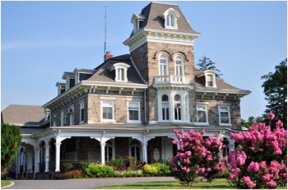Cylburn Arboretum
 4915 Greenspring Ave. • Baltimore 21209
4915 Greenspring Ave. • Baltimore 21209
Melissa Grim, Chief Horticulturist
410-396-0180
Email Melissa
Event Coordinator
410-396-4860
The Cylburn Arboretum was originally the private estate of businessman Jesse Tyson, who started construction of Cylburn Mansion in 1863 as a summer home for himself and his widowed mother. Cylburn Mansion was designed by George A. Frederick, who was also the architect for Baltimore’s City Hall. Victorian Renaissance Revival in design, Cylburn was built of gneiss quarried and was noted for its inlaid floors, marble baths, leaded glass, plasterwork, tall windows and wide porches. Formal gardens and lawns with trees planted by Jesse Tyson himself were surrounded by natural woodland filled with wildflowers, wildlife and native and migrating birds.
The City of Baltimore purchased the estate at auction for $42,300. In keeping with a 1903 study by the noted landscaping firm Olmsted Brothers, the Cylburn property was to be used for parkland. But in April 1943, the Park Board lent the Cylburn Mansion to the Department of Public Welfare as a home for forty neglected and abandoned children. The first five children, brothers and sisters ranging in age from 4 to 11, came to the mansion on June 11, 1943.
More children arrived in the following months, all of them white. In August 1945, plans were made to renovate a 14-room tenant house, to be called the Talbert House, for neglected Negro boys. However, it burned down before renovations could be completed. In the spring of 1954, integration began at Cylburn, first with the staff, then with the children, who had no trouble accepting integration even when churches, theaters, ice cream shops, scout troops and other organizations did not. In December 1957, the children living in the mansion were moved to a new home for children on Cold Spring Lane. Cylburn children still write letters filled with happy memories of growing up in the mansion, and on occasion, they visit.
In 1954, at the behest of Elizabeth Clarke, who worked for the Department of Recreation and Parks, the City founded the Cylburn Wildflower Preserve and Garden Center. The purpose was two-fold: to enable adults and youth to understand and enjoy the out-of-doors and to preserve the existing natural beauty and facilities of “Cylburn Park.” Volunteers designed twelve miles of trails and later, with a grant from the Sears Roebuck Company, restored the formal gardens. In December 1957, when the last of the children housed at Cylburn by the City departed, the rooms in the mansion became offices for the Cylburn Wildflower Preserve and Garden Center.
By virtue of its long history and its contribution “in the fields of science and education,” the Cylburn mansion and most of the land were designated as an historical and architectural preservation site and were placed on the National Register in 1971.
On January 7, 1982, the Cylburn newsletter announced that the Cylburn parkland had been renamed Cylburn Arboretum and the volunteer group the Cylburn Arboretum Association. The name “arboretum” acknowledged the rich natural resources of the Cylburn property and the long history of careful stewardship of its lawns, gardens, planted trees and natural woodland. Since 1982, Cylburn has flourished as an arboretum, a park, and an education center.
The Vollmer Visitor and Education Center
Today Cylburn is Baltimore's largest public garden! Cylburn Association uses the gardens and surrounding nature as the staging area for educational programs and activities for all ages. Between 2008 and 2010, Cylburn constructed 2 new buildings. The Vollmer Visitor and Education Center was built utilizing many green building techniques. It features modern solutions to reduce the building’s impact on the environment like composting toilets, a “living” green roof, and geothermal heating and cooling.
A private estate that for more than a century had seen the unfolding of Baltimore history became a public site for the study of natural history—a rich repository of Baltimore’s geologic and ecological and horticultural past. Come and see all that Cylburn Arboretum has to offer. Cylburn Arboretum is accessible by bus route #1 which stops just west of the intersection of Greenspring Avenue and Cylburn Avenue.
RATES & APPLICATIONS
Visit our RENTALS page to explore Cylburn Arboretum's rental rates and information.
AMENITIES
- Beautiful gardens
- Summer Nature Camp
- Food systems lab (Aquaponics)
- Membership opportunities available
- Volunteer opportunities
- Visitor and Education Center
- Wedding and event rentals available at the Mansion
- Greenhouse complex and classrooms
- Accessible by MTA Bus Route #1
IN PROXIMITY TO…
- I-83
- Callowhill Recreation Center
- Sinai Hospital
- Coldspring-Newtown
